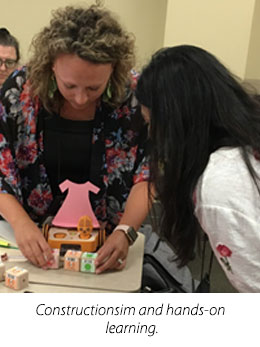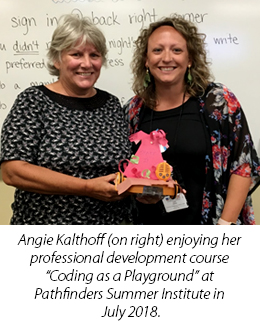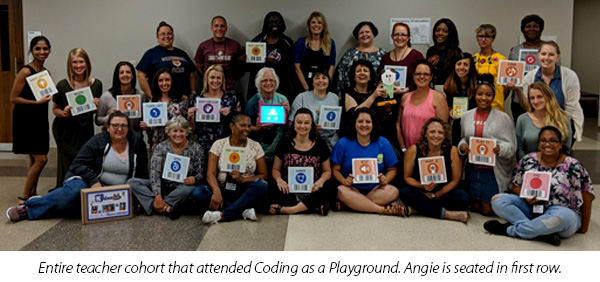Coding as a Playground
by Angie Kalthoff @mrskalthoff | December 11, 2018
As a technology integrationist and former English teacher, Angie Kalthoff works to build and connect communities with opportunities as they strive to drive innovation through a growth mindset. Her focus on elementary education, allows her to think about how computer science and computational thinking can be integrated into all classrooms.
As one of the attendees at the Coding as a Playground cohort at Pathfinders Summer Institute, I left the week of learning with a new understanding of what Computer Science (CS) education can look like in primary classrooms. The following words come to mind as I think about my experience:
- Constructionism
- Hard Fun
- Body Syntonic
- Epistemology
Constructionism

This is the approach we took for learning at the institute. In the Coding as a Playground: ScratchJr + KIBO cohort, a lot of our activities were based on research from Dr. Marina Umaschi Bers. We spent the week thinking about how the integration of computer science into our primary learning environments could affect our students’ learning. We had hands on time to learn about coding as a literacy by creating programs for characters on an iPad with ScratchJr using a block based language and the robot KIBO from Kinderlab Robotics. Constructionism can be thought of as a way for everything to be understood by being constructed. Dr. Marina Bers' work with Seymour Papert encourages learning through hands on active interactions. If you want to learn more about constructionism I recommend this article.
Hard Fun
We had a lot of “Hard Fun.” A phrase that was coined by Alan Kay and refers to an activity that engages us because it is enjoyable but at the same time challenging. We were able to spend time interacting with coding on iPads and with robots as both learners and teachers. We took time to build our background knowledge together, then think about how it could apply in our classrooms. Each night we had a reading assignment from Coding as a Playground, by Dr. Marina Bers, that we could discuss in class with our peers the next day. I had read this book prior to attending the institute but hadn’t yet had much time to thoughtfully discuss my learning with peers.
For additional Hard Fun reading I recommend http://www.papert.org/articles/HardFun.html
Body Syntonic

Seymour Papert described body syntonic as a way to refer to experiences that are related to one's knowledge and sense about one's body. As I created programs to move Kitty, in ScratchJr, and KIBO, the robot, I thought about how I move in relation to the objects I was controlling. The objects moved in the way I moved. This was helpful when creating programs to make them do what I wanted them to do. I often would see students moving their head, hands, even whole body as they created their code. I understood what they were doing and why they were doing it but I didn’t know what it was called. To learn more about body-syntonic learning I recommend this article.
Epistemology - Creating Meaningful Projects
This happens when projects are chosen because of a personal connection or interest. In these projects, epistemology refers to when learners engage in exploring nature of knowledge itself. Learners are thinking about their thinking, making connections, and forming an opinion.
As a class we had a challenge to create a dance for Kibo. My teacher partner, Janice, and I decided to create a dance to Shake if Off by Taylor Swift. We picked her song because it is one we both know and our students talk about. Our facilitators didn’t give us direct instruction for each programming block we used. Instead, we learned about the blocks by using them in our program. Our program wasn’t perfect the first time and we had to spend time debugging, finding and fixing mistakes. We went through the engineering design process in our allotted amount of time for this project. As seen on Kinderlabs website, at a young age, the engineering design process can be explained by the following steps which continue to repeat:
- Ask
- Imagine
- Plan
- Create
- Test and improve
- Share
Then we were able to share out project with an authentic audience, our peers in the cohort.
After having hands on experience with both ScratchJr and KIBO, we discussed how to assess our student learning. Questions I posed to myself include:
- What are we looking for?
- Is it the process or a final product?
- How does this fit into classroom instruction that is already taking place?
- Is this going to be seen as “one more thing”?
Through these discussions and exploring the DevTech site, I came across research from former students. One study that stood out to me for understanding student learning was called Code and tell: assessing young children's learning of computational thinking using peer video interviews with ScratchJr by Dylan Portelance and Marina Bers.
Code and Tell
Initially, my process for providing a grade with CS projects revolved around an interdisciplinary approach including ELA, Math, and Science standards. I was focused on the end product. The more time I have had to explore CS in classrooms, the more I am driven towards assessing the learning process and less about the final outcome. One way to do this is by conducting Code and Tell-like practices which is a technique that can show a broad range of what young children can learn about computational thinking in classroom interventions using ScratchJr than more traditional assessment techniques, as described by Dylan Portelance. To learn more, I recommend this article.
Positive Technological Development (PTD)
While some people may think that computers and robots isolate children, work done by Muller and Perlmutter show that children at the computer spent nine times as much time talking to their peers while using computers (Muller & Perlmutter, 1985) Dr. Bers' work around PTD shares the importance of teamwork and management of frustration. While attending the institute we all had experience with both! Before attending the institute, I had incorporated a lot of time for Pair Programming in classrooms. Pair programing involves having two learners, use one device, with specific roles for each learner.
Based on my experience at the institute, I am encouraged to provide more hands on time for my learners (both kids and adults) to learn by doing. I am also sharing research, examples of what coding as a literacy can look like in elementary classrooms, and making connections between existing projects and standards with skills the CSTA Standards layout for educators when thinking about how to bring CS into classrooms.
Do you want to follow research at DevTech? Sign up here to receive news about current research projects and upcoming events.
Learn more about my experience at the Circl Educators Corner.
Note: (Muller & Perlmutter, 1985) preschool children's problem-solving interactions at computers and jigsaw puzzles. Journal of applied developmental psychology.


